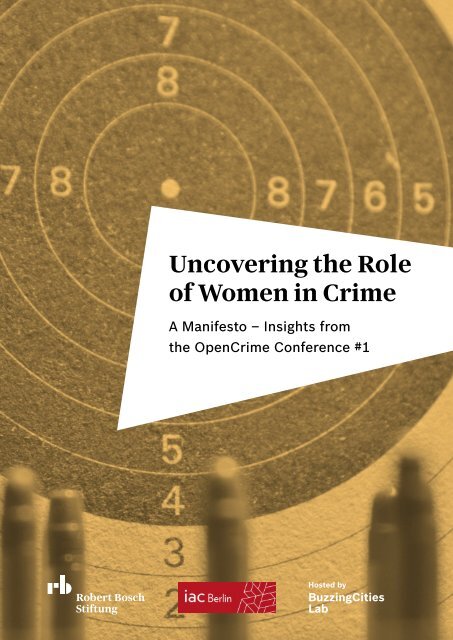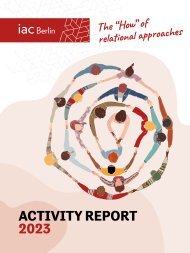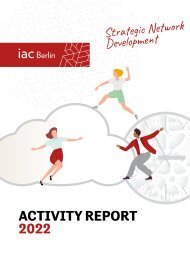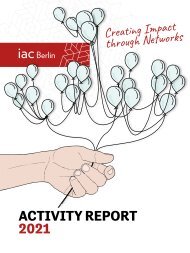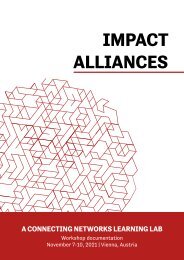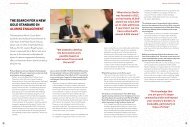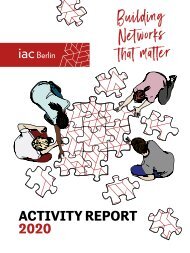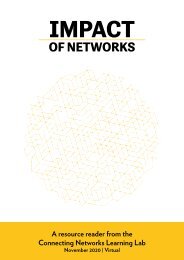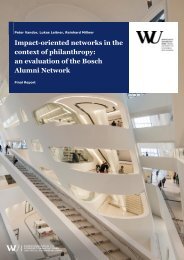Uncovering the Role of Women in Crime - A Manifesto
Women play an increasingly important role as members or supporters for criminal and terrorist organizations, but they can also become key stakeholders in the fight against crime. At the OpenCrime conference #1 on “The Role of Women in Crime” by the think tank BuzzingCities Lab that took place within the Bosch Alumni Network in Berlin, investigative journalists, criminologists and other crime and security experts took a closer look at the trends and challenges related to the role of women in crime and within the justice system and developed recommendations on how to improve reporting on the phenomenon.
Women play an increasingly important role as members or supporters for criminal and terrorist organizations, but they can also become key stakeholders in the fight against crime.
At the OpenCrime conference #1 on “The Role of Women in Crime” by the think tank BuzzingCities Lab that took place within the Bosch Alumni Network in Berlin, investigative journalists, criminologists and other crime and security experts took a closer look at the trends and challenges related to the role of women in crime and within the justice system and developed recommendations on how to improve reporting on the phenomenon.
You also want an ePaper? Increase the reach of your titles
YUMPU automatically turns print PDFs into web optimized ePapers that Google loves.
<strong>Uncover<strong>in</strong>g</strong> <strong>the</strong> <strong>Role</strong><br />
<strong>of</strong> <strong>Women</strong> <strong>in</strong> <strong>Crime</strong><br />
A <strong>Manifesto</strong> – Insights from<br />
<strong>the</strong> Open<strong>Crime</strong> Conference #1<br />
Hosted by<br />
Buzz<strong>in</strong>gCities<br />
Lab
<strong>Women</strong> play an <strong>in</strong>creas<strong>in</strong>gly important role<br />
as members or supporters for crim<strong>in</strong>al and<br />
terrorist organizations, but <strong>the</strong>y can also<br />
become key stakeholders <strong>in</strong> <strong>the</strong> fight aga<strong>in</strong>st<br />
crime. The Open<strong>Crime</strong> conference discovered<br />
current bl<strong>in</strong>dspots and upcom<strong>in</strong>g challenges.<br />
The role <strong>of</strong> women as a group affected by organized or<br />
domestic crime, as <strong>of</strong>fenders as well as potential changemakers,<br />
is <strong>of</strong>ten overlooked <strong>in</strong> media and public debates.<br />
But <strong>the</strong> radicalization and imprisonment rates <strong>of</strong> female<br />
<strong>of</strong>fenders are on <strong>the</strong> rise globally, as well as <strong>the</strong> rate <strong>of</strong> hate<br />
crimes aga<strong>in</strong>st women - <strong>in</strong>clud<strong>in</strong>g <strong>in</strong> <strong>the</strong> digital realm.<br />
<strong>Women</strong> can also play a vital role <strong>in</strong> crime prevention and<br />
o<strong>the</strong>r anti-crime strategies.<br />
At <strong>the</strong> Open<strong>Crime</strong> conference #1 on “The <strong>Role</strong> <strong>of</strong> <strong>Women</strong> <strong>in</strong><br />
<strong>Crime</strong>” by <strong>the</strong> th<strong>in</strong>k tank Buzz<strong>in</strong>gCities Lab that took place<br />
with<strong>in</strong> <strong>the</strong> Bosch Alumni Network <strong>in</strong> Berl<strong>in</strong>, <strong>in</strong>vestigative<br />
journalists, crim<strong>in</strong>ologists and o<strong>the</strong>r crime and security<br />
experts from organizations like Investigative Report<strong>in</strong>g<br />
Project Italy (IRPI), Mafia? Ne<strong>in</strong>, Danke!, Organized <strong>Crime</strong><br />
& Corruption Report<strong>in</strong>g Project (OCCPR), K<strong>in</strong>g`s College<br />
London, Netzpolitik.org and Amnesty International took a<br />
closer look at <strong>the</strong> trends and challenges related to <strong>the</strong> role<br />
<strong>of</strong> women <strong>in</strong> crime and with<strong>in</strong> <strong>the</strong> justice system and developed<br />
recommendations on how to improve report<strong>in</strong>g on<br />
<strong>the</strong> phenomenon.<br />
Photos: Nick Jaussi, Cover photo: Sonja Peteranderl
Renounce sexist stereotypes: Media<br />
coverage should avoid gender clichés when<br />
report<strong>in</strong>g on <strong>the</strong> role <strong>of</strong> women <strong>in</strong> crime.<br />
Too <strong>of</strong>ten, media coverage focuses on unusual cases and<br />
stereotypes – and represents only a fraction <strong>of</strong> reality.<br />
Crim<strong>in</strong>al women are stylized <strong>in</strong>to beasts or unapproachable,<br />
almost mythical persons.<br />
Amanda Knox, <strong>the</strong> young American woman accused <strong>in</strong> Italy<br />
<strong>of</strong> her alleged <strong>in</strong>volvement <strong>in</strong> <strong>the</strong> murder <strong>of</strong> Meredith Kercher<br />
and later acquitted, was given <strong>the</strong> name „The Angel with <strong>the</strong><br />
Ice Eyes“ worldwide. Her story also became a Netflix movie.<br />
Reports about <strong>the</strong> ma<strong>in</strong> accused defendant <strong>in</strong> <strong>the</strong> trial <strong>of</strong><br />
<strong>the</strong> German right w<strong>in</strong>g extremist terror cell NSU, Beate<br />
Zschäpe, <strong>of</strong>ten focused on her appearance, her clo<strong>the</strong>s and<br />
her mood. <strong>Women</strong> who jo<strong>in</strong> cartels or terrorist organizations<br />
are regularly sexualized – like <strong>the</strong> German „ISIS bride“ Derya.<br />
When <strong>the</strong> media portray <strong>the</strong> crimes and character traits <strong>of</strong><br />
crim<strong>in</strong>al women, this is subject to different rules than <strong>the</strong><br />
report<strong>in</strong>g about male <strong>of</strong>fenders. Journalists should make sure<br />
that <strong>the</strong>y are not fall<strong>in</strong>g <strong>in</strong>to sexist clichés and that <strong>the</strong>y<br />
pay attention to facets beyond rigid victim or perpetrator<br />
dichotomies.<br />
Pay attention to <strong>the</strong> patterns: <strong>Women</strong><br />
commit different crimes than men - and <strong>the</strong>y<br />
commit <strong>the</strong>m differently.<br />
Crim<strong>in</strong>al women are an exception <strong>in</strong> statistical terms. Accord<strong>in</strong>g<br />
to <strong>the</strong> UN report „Global Study on Homicide“, violence<br />
is male-dom<strong>in</strong>ated: More than 80 percent <strong>of</strong> <strong>the</strong> murder<br />
victims registered <strong>in</strong> 2017 worldwide were boys and men<br />
– <strong>in</strong> recent years, also more than 90 percent <strong>of</strong> <strong>the</strong> murder<br />
suspects were male.<br />
Accord<strong>in</strong>g to <strong>the</strong> UN, around 87,000 women were murdered<br />
<strong>in</strong> 2017, more than half <strong>of</strong> whom were killed by partners or<br />
family members. However, women do become perpetrators<br />
<strong>of</strong> domestic violence, albeit to a lesser extent, especially<br />
when it comes to care: for example, <strong>the</strong> abuse <strong>of</strong> children<br />
or people <strong>in</strong> need for long-term care. Here, <strong>the</strong> proportion<br />
<strong>of</strong> female crim<strong>in</strong>als is higher simply because <strong>the</strong> upbr<strong>in</strong>g<strong>in</strong>g<br />
<strong>of</strong> children and care is predom<strong>in</strong>antly provided by women.<br />
The same applies to female serial killers who, accord<strong>in</strong>g to<br />
<strong>the</strong> US crim<strong>in</strong>ologist Scott Bonn, do not make up more than
20 percent <strong>of</strong> <strong>the</strong> perpetrator group. „Unlike male serial<br />
killers, <strong>the</strong>y rarely look for victims <strong>in</strong> public, but f<strong>in</strong>d <strong>the</strong>m<br />
<strong>in</strong> <strong>the</strong>ir family or at work,“ writes Bonn. They tend to become<br />
active only where <strong>the</strong>y know <strong>the</strong>ir way around.<br />
As a rule, women commit less serious crimes than men.<br />
Often it is about <strong>the</strong>ft, fraud or <strong>in</strong>sult. Accord<strong>in</strong>g to crime<br />
statistics, more than 80 percent <strong>of</strong> violent crimes <strong>in</strong> Germany<br />
are committed by men. Instead <strong>of</strong> focus<strong>in</strong>g on bloody isolated<br />
acts, news coverage should ra<strong>the</strong>r uncover, analyze and<br />
make comprehensible larger contexts, trends and social<br />
causes related to crime and <strong>the</strong> judicial system.<br />
Don’t fall for <strong>the</strong> Narco pr<strong>in</strong>cess story: The<br />
role <strong>of</strong> women <strong>in</strong> crim<strong>in</strong>al ecosystems has to<br />
be revalued.<br />
Men cont<strong>in</strong>ue to dom<strong>in</strong>ate crim<strong>in</strong>al organizations, but <strong>the</strong><br />
role <strong>of</strong> women <strong>in</strong> <strong>the</strong> crim<strong>in</strong>al ecosystem is underestimated.<br />
„The Italian mafia groups are dom<strong>in</strong>ated by men. But <strong>the</strong><br />
success <strong>of</strong> <strong>the</strong> mafia depends on women,“ says <strong>the</strong> Australian<br />
journalist Connie Agius from ABC News, who has researched<br />
<strong>the</strong> role <strong>of</strong> women <strong>in</strong> <strong>the</strong> Italian mafia.<br />
She says women act as political pawns, as b<strong>in</strong>d<strong>in</strong>g elements<br />
between mafia families and as couriers. „Despite <strong>the</strong> machismo,<br />
<strong>the</strong> ‚men <strong>of</strong> honour’ are po<strong>in</strong>t<strong>in</strong>g out that a daughter<br />
is marry<strong>in</strong>g <strong>in</strong>to ano<strong>the</strong>r mafia family to resolve conflicts,<br />
and a mo<strong>the</strong>r is teach<strong>in</strong>g her children <strong>the</strong> values <strong>of</strong> crime<br />
to ensure <strong>the</strong> survival <strong>of</strong> <strong>the</strong> organization and protect her<br />
bus<strong>in</strong>ess <strong>in</strong>terests”, Agius says. „They need a woman and a<br />
sister to send messages to and from prison cells or to launder<br />
money. Mafia bus<strong>in</strong>ess can’t thrive without a woman.“<br />
Even <strong>in</strong> countries like Mexico and Brazil, women play an<br />
<strong>in</strong>creas<strong>in</strong>gly active role <strong>in</strong> gangs and cartels. In management<br />
or key positions, however, <strong>the</strong>y are usually only promoted if<br />
<strong>the</strong>y <strong>the</strong>mselves come from a crim<strong>in</strong>al family, if <strong>the</strong>ir husbands<br />
are <strong>in</strong> prison or if <strong>the</strong>y were murdered <strong>in</strong> a drug war.<br />
Media report<strong>in</strong>g focuses above all on <strong>the</strong> starlets <strong>of</strong> <strong>the</strong><br />
Narco scene such as Mexico’s best-known ex-drug queen<br />
Sandra Ávila Beltrán or Emma Coronel, <strong>the</strong> wife <strong>of</strong> <strong>the</strong> imprisoned<br />
S<strong>in</strong>aloa drug boss Joaquín „El Chapo“ Guzmán.<br />
But <strong>the</strong> reality <strong>of</strong> most women work<strong>in</strong>g for gangs and cartels<br />
is precarious. It is women with little education and low<br />
<strong>in</strong>come who <strong>of</strong>ten enter drug smuggl<strong>in</strong>g to escape poverty.<br />
The risk <strong>of</strong> be<strong>in</strong>g arrested while smuggl<strong>in</strong>g is high.
„Although <strong>the</strong>re are women who manage to rise <strong>in</strong> <strong>the</strong><br />
crim<strong>in</strong>al world, <strong>the</strong>ir ma<strong>in</strong> activities are mostly smuggl<strong>in</strong>g,<br />
drug traffick<strong>in</strong>g with smaller quantities and smuggl<strong>in</strong>g drugs<br />
<strong>in</strong>to prisons,“ writes Mexican sociologist Elsa Ivette Jiménez<br />
Valdez <strong>in</strong> an analysis. <strong>Women</strong> are still less recognized <strong>in</strong><br />
crim<strong>in</strong>al organizations than men, are paid less, and <strong>the</strong><br />
majority take on riskier jobs.<br />
Follow <strong>the</strong> Money: Journalists who <strong>in</strong>vestigate<br />
<strong>the</strong> f<strong>in</strong>ancial backbones <strong>of</strong> crim<strong>in</strong>al organizations<br />
should not forget about <strong>the</strong> women.<br />
In <strong>the</strong> Italian mafia, but also among Russian oligarchs, crim<strong>in</strong>ally<br />
acquired assets are <strong>in</strong>creas<strong>in</strong>gly parked <strong>in</strong> women’s<br />
bank accounts - <strong>the</strong>y are less conspicuous, have no crim<strong>in</strong>al<br />
record. The crim<strong>in</strong>al orig<strong>in</strong> <strong>of</strong> <strong>the</strong> money can thus be better<br />
concealed. Accord<strong>in</strong>g to <strong>the</strong> journalist network Investigative<br />
Report<strong>in</strong>g Project Italy (IRPI), mafiosi <strong>in</strong> Italy <strong>of</strong>ten use <strong>the</strong>ir<br />
wives and sisters’ assets <strong>in</strong> order to protect accounts and<br />
real estate from <strong>the</strong> authorities.<br />
Accord<strong>in</strong>g to <strong>the</strong> Transcrime research center, one third <strong>of</strong><br />
all mafia assets <strong>in</strong> Italy are owned by women - at <strong>the</strong> same<br />
time, <strong>the</strong> proportion <strong>of</strong> women convicted <strong>in</strong> <strong>the</strong> mafia<br />
context is only 2.5 per cent. The proportion <strong>of</strong> women as<br />
owners or participants <strong>of</strong> confiscated mafia companies is<br />
twice as high as <strong>the</strong> proportion <strong>of</strong> female company owners<br />
<strong>in</strong> <strong>the</strong> legal economy.<br />
Brazil’s corruption scandals <strong>of</strong> recent years have also<br />
repeatedly brought cases to public attention <strong>in</strong> which highrank<strong>in</strong>g<br />
politicians have laundered bribes via <strong>the</strong>ir wife’s<br />
bank accounts. <strong>Women</strong> and children are becom<strong>in</strong>g strategic<br />
figures <strong>in</strong> complex money-launder<strong>in</strong>g systems.<br />
Exam<strong>in</strong>e <strong>the</strong> <strong>in</strong>fluence <strong>of</strong> <strong>the</strong> family: The<br />
social context needs to be taken <strong>in</strong>to account<br />
more – as factor for radicalization as well as<br />
deradicalization.<br />
When report<strong>in</strong>g on <strong>the</strong> role <strong>of</strong> women <strong>in</strong> crime and radicalisation,<br />
<strong>the</strong> family context must be given greater consideration.<br />
If, for example, a woman is imprisoned, this also affects<br />
<strong>the</strong> children.
Journalists should also take a closer look at gender and<br />
terrorism. Accord<strong>in</strong>g to <strong>the</strong> Global Terrorism Index 2019,<br />
thirteen per cent <strong>of</strong> ISIS foreign recruits were female, with<br />
<strong>the</strong> majority <strong>of</strong> female recruits jo<strong>in</strong><strong>in</strong>g from <strong>the</strong> MENA region.<br />
More than 1.000 German Islamists have travelled to war<br />
zones <strong>of</strong> ISIS <strong>in</strong> recent years. About 50 German women and<br />
62 children were last deta<strong>in</strong>ed or <strong>in</strong> refugee camps <strong>in</strong> Iraq<br />
or Syria - who as German citizens have <strong>the</strong> right to return.<br />
The sentenc<strong>in</strong>g <strong>of</strong> women for ISIS support is <strong>of</strong>ten a grey<br />
area. An ISIS returnee was recently convicted by <strong>the</strong> Stuttgart<br />
Higher Regional Court for her terrorist propaganda;<br />
however, it is controversial <strong>in</strong> <strong>the</strong> case <strong>of</strong> women who, for<br />
example, followed <strong>the</strong>ir husbands to ISIS areas what <strong>the</strong>y<br />
can be charged with.<br />
The family context can also be a factor that can help with<br />
deradicalisation. “In my experience, mo<strong>the</strong>rhood can be a<br />
motivation to get out <strong>of</strong> <strong>the</strong> mafia,“ says <strong>in</strong>vestigative reporter<br />
Lorenzo Bodrero <strong>of</strong> <strong>the</strong> Investigative Report<strong>in</strong>g Project Italy<br />
(IRPI). „Suddenly, women are no longer solely responsible<br />
for <strong>the</strong>ir own actions. Not everyone immediately draws <strong>the</strong><br />
l<strong>in</strong>e, but at least <strong>the</strong>y th<strong>in</strong>k about it - and that’s a doubt<br />
that can be used,“ says Bodrero. He believes that journalists<br />
should more <strong>of</strong>ten tell <strong>the</strong> stories <strong>of</strong> women who have<br />
succeeded <strong>in</strong> gett<strong>in</strong>g out - as <strong>in</strong>spiration for o<strong>the</strong>rs, but also<br />
to better understand <strong>the</strong>ir psychological pr<strong>of</strong>ile, background<br />
and motivations.<br />
Invisible <strong>in</strong>mates: What’s go<strong>in</strong>g on <strong>in</strong><br />
prisons for women must become more<br />
transparent.<br />
Prisons are parallel worlds from which reports are seldom<br />
made. This does not only apply to women who are beh<strong>in</strong>d<br />
bars. „On <strong>the</strong> one hand, it is a topic that usually requires a<br />
lot <strong>of</strong> research work and a lot <strong>of</strong> access and thus patience,<br />
on <strong>the</strong> o<strong>the</strong>r hand, some colleagues do not dare to do it<br />
because it requires specific niche knowledge,“ observes <strong>the</strong><br />
freelance journalist Alexander Krützfeldt.<br />
In cooperation with Süddeutscher Zeitung, Correctiv and<br />
BR, Krützfeldt has published <strong>the</strong> <strong>in</strong>vestigation series „Acht<br />
Häftl<strong>in</strong>ge“ (Eight Prisoners) as well as a book <strong>of</strong> <strong>the</strong> same<br />
name about German prisons. „There’s a fear to fail at <strong>the</strong><br />
topic or not to do it justice.“ Prisons are reported about<br />
above all when, for example, an outbreak has happened.<br />
Access to prisons is difficult to access, Krützfeldt says:
“There are some prisons that are very open - mostly those that<br />
have just been renovated and have presentable concepts.”<br />
Prisons are too rarely geared to <strong>the</strong> special needs <strong>of</strong> women<br />
– because <strong>the</strong> majority <strong>of</strong> prisoners are male. Accord<strong>in</strong>g to<br />
<strong>the</strong> German Federal Statistical Office, fewer than 3.000 <strong>of</strong> a<br />
total <strong>of</strong> 60.000 prisoners and preventive deta<strong>in</strong>ees were women<br />
<strong>in</strong> 2018. In <strong>the</strong>ir research, Krützfeld and his colleagues<br />
have <strong>the</strong>refore only focused on men, „because women’s<br />
imprisonment is completely different <strong>in</strong> terms <strong>of</strong> groups,<br />
needs, violence and health”, he says: „We could only cover<br />
one aspect with our means.“<br />
Future research could explore, for example, how imprisonment<br />
<strong>in</strong>fluences <strong>the</strong> relationship between mo<strong>the</strong>rs and<br />
children, to what extent sexual abuse occurs <strong>in</strong> women’s<br />
prisons or how sexual hygiene works <strong>in</strong> <strong>the</strong> prison context.<br />
The voices <strong>of</strong> <strong>in</strong>mates could also be made more visible.<br />
Innovate: New technologies help to<br />
illustrate events and biographies that are<br />
difficult to visualize.<br />
Report<strong>in</strong>g on crimes is not so easy. If <strong>the</strong> crimes were<br />
committed years ago, those <strong>in</strong>volved may be dead. When<br />
it comes to organized crime, gangs, cartels and <strong>the</strong> mafia,<br />
research is not without its dangers for those <strong>in</strong>volved as<br />
well as journalists. Access to crime scenes, witnesses<br />
or ex-crim<strong>in</strong>als is <strong>of</strong>ten blocked or controlled by active<br />
members.<br />
New technologies and forms <strong>of</strong> storytell<strong>in</strong>g can help not<br />
only to dive <strong>in</strong>to <strong>the</strong> past, but also to make revenge-prone<br />
people a part <strong>of</strong> history. In <strong>the</strong> documentary „Se potessi<br />
tornare. Donne <strong>in</strong> fuga dal crim<strong>in</strong>e“ (If I could return. <strong>Women</strong><br />
on <strong>the</strong> run from crime) by IRPI, for example, a mafia<br />
escapist from a witness protection program uses a virtual<br />
reality headset to virtually visit places <strong>of</strong> her past – on <strong>the</strong><br />
one hand, <strong>the</strong> viewer can walk through <strong>the</strong> places, on <strong>the</strong><br />
o<strong>the</strong>r hand, he experiences <strong>the</strong> reactions and emotions <strong>of</strong><br />
<strong>the</strong> escapist.<br />
Investigative journalists also have to protect <strong>the</strong>ir communication,<br />
technical devices, documents and sources – however,<br />
<strong>the</strong>re are considerable vulnerabilities <strong>in</strong> both operational<br />
and IT security.
Exam<strong>in</strong>e <strong>the</strong> digital weapons: Digital<br />
violence is also a form <strong>of</strong> violence.<br />
Digital violence is a form <strong>of</strong> violence that frequently affects<br />
women, but is still too little noticed – <strong>the</strong>re are numerous<br />
<strong>in</strong>dividual case anecdotes, but no representative studies on<br />
<strong>the</strong> topic yet.<br />
Accord<strong>in</strong>g to <strong>the</strong> German Federal Association <strong>of</strong> <strong>Women</strong>’s<br />
Counsell<strong>in</strong>g Centres bff, it is digital violence when people<br />
are „deliberately <strong>in</strong>sulted, exposed, isolated, blackmailed<br />
and threatened“ us<strong>in</strong>g digital means such as mobile phones<br />
or <strong>the</strong> Internet.<br />
The phenomenon <strong>in</strong>cludes various forms <strong>of</strong> attacks with<br />
which <strong>the</strong> perpetrators want to achieve a disparagement,<br />
damage to reputation, social isolation and <strong>the</strong> coercion or<br />
blackmail <strong>of</strong> a certa<strong>in</strong> behaviour <strong>of</strong> those affected. In <strong>the</strong><br />
field <strong>of</strong> domestic violence, perpetrators use tools such as<br />
spyware to ga<strong>in</strong> control over communications and track <strong>the</strong><br />
victim’s whereabouts – which opens a gateway to physical<br />
violence and crimes.
Buzz<strong>in</strong>gCities Lab is a th<strong>in</strong>k tank founded by <strong>the</strong> journalists<br />
and researchers Julia Jaroschewski and Sonja Peteranderl<br />
that <strong>in</strong>vestigates <strong>the</strong> impact <strong>of</strong> digitalization on urban violence,<br />
security and organized crime <strong>in</strong> megacities worldwide.<br />
The Open<strong>Crime</strong> <strong>in</strong>itiative by Buzz<strong>in</strong>gCities Lab connects<br />
<strong>in</strong>terdiscipl<strong>in</strong>ary experts to discuss crime trends and strategies<br />
to prevent and fight violence and crime.<br />
Buzz<strong>in</strong>gCities.com<br />
Buzz<strong>in</strong>gCities@gmail.com<br />
@Buzz<strong>in</strong>gCities


